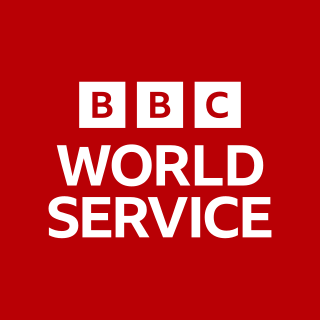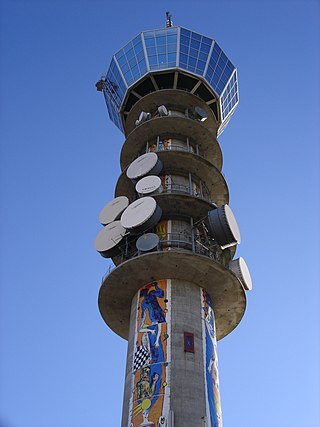This article reads more like a story than an encyclopedia entry.(November 2011) |
Transradio Press Service was founded by Herbert Moore in 1934. Its mission was to supply news to radio stations by teleprinter and shortwave. The service folded in 1951.
This article reads more like a story than an encyclopedia entry.(November 2011) |
Transradio Press Service was founded by Herbert Moore in 1934. Its mission was to supply news to radio stations by teleprinter and shortwave. The service folded in 1951.
After leaving CBS in 1934 Herbert Moore, a former United Press reporter, [1] had an idea, why not set up a service to provide copy for radio news broadcasts. At that time many radio stations were limited by the big press services to just two five-minute broadcasts per day and many had shoddy news writing services. Moore was able to raise $150,000 of start up capital and launch the Transradio Press Service in Manhattan. [2] [3]
When the service began it had 50 radio clients and another 75 clients which received limited news by shortwave radio. Some of Transradio's early clients included: KNX in Hollywood, KSTP in St. Paul, the Michigan Network, the Yankee Network in New England, WLS in Chicago and KWK in St. Louis. Transradio charged different rates for different clients, depending on their market. A station in Casper, Wyoming paid only $15 per week while the Yankee Network paid $1000 per week. [4]
In Oct. 1934 Moore managed to work out a deal with WOR in Manhattan for $1500 a week. The deal launched Transradio into the largest radio market in the country.
Transradio took off, within five years the company had 400 radio and newspaper clients and 600 stringers and reporters worldwide. In fact, Transradio's success was influential over the other big news services, Associated Press, United Press and the International News Service. They all soon realized that they had missed the boat with radio coverage and began to peddle their own news to radio stations. This put the squeeze on the upstart Transradio. [5] [6] [7] [8]
By 1940 Transradio was sending news out to hundreds of stations in the U.S. and Canada, distributing foreign news from France's Agence Havas, Britain's Central News Agency, Germany's Transocean News Service (part of DNB (Deutsche Nachrichten Buro)), British Official Wireless, and its own private sources, including the pioneering foreign correspondent Betty Wason, who started the Czechoslovakian bureau in 1938. In 1940 year Canadian authorities expressed their ire with commercially sponsored news, which was outlawed in Canada, when Transport Minister Clarence Howe arose in Ottawa's House of Commons and announced the two sponsored news services in Canada, Transradio and British United Press, must "show their news sources to be accurate," or risk losing their licenses on July 1. [9] [10]
Moore stormed up to Ottawa and claimed there was a plot by "selfish publishing and monopolistic interests ... to destroy independent news services throughout the Dominion." As the licenses were set to expire the Canadian Broadcasting Corporation, whose own unsponsored news came from Canadian Press, reversed the decision and agreed to let Transradio transmit indefinitely.[ citation needed ]
Herbert Moore left Transradio in 1942 for the publishing business and his brother, Robert Moore, took over as president.
Transradio folded in 1951 with only 50 clients and 25 staff left.

The BBC World Service is an international broadcaster owned and operated by the BBC. It is the world's largest external broadcaster in terms of reception area, language selection and audience reach. It broadcasts radio news, speech and discussions in more than 40 languages to many parts of the world on analogue and digital shortwave platforms, internet streaming, podcasting, satellite, DAB, FM and MW relays. In 2015, the World Service reached an average of 210 million people a week. In November 2016, the BBC announced that it would start broadcasting in additional languages including Amharic and Igbo, in its biggest expansion since the 1940s.

Shortwave radio is radio transmission using shortwave (SW) radio frequencies. There is no official definition of the band, but the range always includes all of the high frequency band (HF), which extends from 3 to 30 MHz ; above the medium frequency band (MF), to the bottom of the VHF band.

The Canadian Broadcasting Corporation, branded as CBC/Radio-Canada, is the Canadian public broadcaster for both radio and television. It is a Crown corporation that receives public funding from the government. The English- and French-language service units of the corporation are commonly known as CBC and Radio-Canada, respectively.

Voice of America is the state-owned news network and international radio broadcaster of the United States of America. It is the largest and oldest of the U.S.-funded international broadcasters. VOA produces digital, TV, and radio content in 48 languages, which it distributes to affiliate stations around the world. Its targeted and primary audience is non-American.
International broadcasting, in a limited extent, began during World War I, when German and British stations broadcast press communiqués using Morse code. With the severing of Germany's undersea cables, the wireless telegraph station in Nauen was the country's sole means of long-distance communication.

Radio broadcasting is the broadcasting of audio (sound), sometimes with related metadata, by radio waves to radio receivers belonging to a public audience. In terrestrial radio broadcasting the radio waves are broadcast by a land-based radio station, while in satellite radio the radio waves are broadcast by a satellite in Earth orbit. To receive the content the listener must have a broadcast radio receiver (radio). Stations are often affiliated with a radio network that provides content in a common radio format, either in broadcast syndication or simulcast, or both. Radio stations broadcast with several different types of modulation: AM radio stations transmit in AM, FM radio stations transmit in FM, which are older analog audio standards, while newer digital radio stations transmit in several digital audio standards: DAB, HD radio, DRM. Television broadcasting is a separate service that also uses radio frequencies to broadcast television (video) signals.

Deutsche Welle, abbreviated to DW, is a German public, state-owned international broadcaster funded by the German federal tax budget. The service is available in 32 languages. DW's satellite television service consists of channels in English, German, Spanish, Persian and Arabic. The work of DW is regulated by the Deutsche Welle Act, meaning that content is intended to be independent of government influence. DW is a member of the European Broadcasting Union (EBU).
Radio Canada International (RCI) is the international broadcasting service of the Canadian Broadcasting Corporation (CBC). Prior to 1970, RCI was known as the CBC International Service. The broadcasting service was also previously referred to as the Voice of Canada, broadcasting on shortwave from powerful transmitters in Sackville, New Brunswick. "In its heyday", said Radio World magazine, "Radio Canada International was one of the world's most listened-to international shortwave broadcasters". However, as the result of an 80 percent budget cut, shortwave services were terminated in June 2012, and RCI became accessible exclusively via the Internet. It also reduced its services to five languages and ended production of its own news service.

It is generally recognized that the first radio transmission was made from a temporary station set up by Guglielmo Marconi in 1895 on the Isle of Wight. This followed on from pioneering work in the field by a number of people including Alessandro Volta, André-Marie Ampère, Georg Ohm and James Clerk Maxwell.

The Canadian Press is a Canadian national news agency headquartered in Toronto, Ontario. Established in 1917 as a vehicle for the time's Canadian newspapers to exchange news and information, The Canadian Press has been a private, not-for-profit cooperative owned and operated by its member newspapers for most of its history. In mid-2010, however, it announced plans to become a for-profit business owned by three media companies once certain conditions were met.
CBC News is a division of the Canadian Broadcasting Corporation responsible for the news gathering and production of news programs on the corporation's English-language operations, namely CBC Television, CBC Radio, CBC News Network, and CBC.ca. Founded in 1941, CBC News is the largest news broadcaster in Canada and has local, regional, and national broadcasts and stations. It frequently collaborates with its organizationally separate French-language counterpart, Radio-Canada Info.

Shortwave listening, or SWLing, is the hobby of listening to shortwave radio broadcasts located on frequencies between 1700 kHz and 30 MHz. Listeners range from casual users seeking international news and entertainment programming, to hobbyists immersed in the technical aspects of radio reception and collecting official confirmations that document their reception of distant broadcasts (DXing). In some developing countries, shortwave listening enables remote communities to obtain regional programming traditionally provided by local medium wave AM broadcasters. In 2002, the number of households that were capable of shortwave listening was estimated to be in the hundreds of millions.

WBCQ is a shortwave radio station operating at Monticello, Maine, United States. The station is owned and operated by Allan Weiner, who also owns and operates WXME AM 780 kHz and WBCQ-FM 94.7 MHz at the shortwave site. WBCQ began operation on September 8, 1998, on 7.415 MHz. The station transmits talk shows and other programs produced by commercial networks as well as former pirate radio broadcasters, including Weiner himself.

CBC North is the Canadian Broadcasting Corporation's radio and television service for the Northwest Territories, Nunavut, and Yukon of Northern Canada as well as Eeyou Istchee and Nunavik in the Nord-du-Québec region of Quebec.
DZRH is a radio station owned and operated by Manila Broadcasting Company, which serves as the flagship station. The station's studio is located at the MBC Building, Star City, Vicente Sotto St., CCP Complex, Roxas Boulevard, Pasay; while its transmitter is located along I. Marcelo St., Brgy. Malanday, Valenzuela. The station has nationwide coverage through its relay stations located across the Philippines.

The BBC General Forces Programme was a national radio station operating from 27 February 1944 until 31 December 1946.

The BBC Allied Expeditionary Forces Programme was a national radio station during World War II in the mid-1940s.
TRANSRADIO SenderSysteme Berlin AG was a German radio communication systems producer, specialised in research, development and design of AM, VHF/FM and DRM such as military and commercial broadcasting systems. Intermediate they were a subsidiary of swiss AMPEGON AG and today an affiliate company of CESTRON International GmbH named Elsyscom GmbH.
Elizabeth Wason was an American writer and broadcast journalist; a pioneer, with such others as Mary Marvin Breckinridge and Sigrid Schultz, of female journalism in the United States. She worked for and with Edward R. Murrow during World War II, although despite her significant contributions she, along with a handful of other journalists closely associated with Murrow, were rarely recognized in the famed group of war correspondents known as the Murrow Boys. She also wrote numerous books on food and cooking from the 1940s through 1981.
Pierre Dufault is a Canadian former journalist and sports commentator. He began as a political correspondent and reporter for the Canadian Football League (CFL) in radio at CKCH then on television at CBOFT-DT. He joined the sports department of Radio-Canada in 1972 as a play-by-play announcer for CFL games and regularly covered the Olympic Games and Commonwealth Games. He was president of Football Reporters of Canada in 1984, became the late night sports report host for Radio-Canada in 1993, and was inducted into the reporters section of the Canadian Football Hall of Fame in 2001.